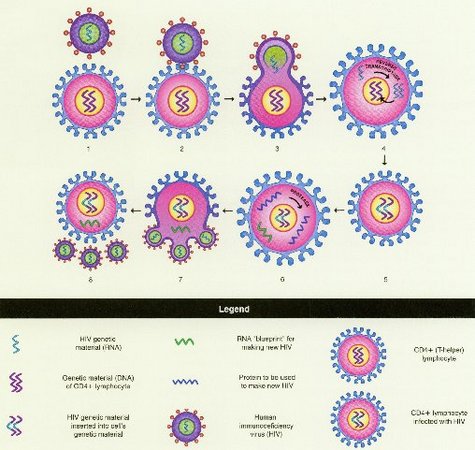The iPrEx study was a randomized, double-blind, placebo-controlled Phase III clinical trial. Participants were randomly assigned to receive on a daily basis an antiretroviral tablet containing combination emtricitabine (FTC 200 milligrams) and tenofovir (TDF 300 milligrams)—a combination known by the brand name Truvada—or a placebo pill. The study was designed to determine whether the daily combination antiretroviral pill could safely and effectively prevent HIV infection among sexually active men who have sex with men and transgendered women who have sex with men, all of whom were routinely counseled about safe sex practices, provided condoms and treated other sexually transmitted infections. Once enrolled, all study participants were evaluated for HIV infection monthly for the duration of their participation in the study (average enrollment was 1.2 years)
What were the results of the iPrEx study?
Investigators found that study participants who took the daily dose of oral antiretrovirals experienced an average of 43.8 percent fewer HIV infections than those who received a placebo pill (95% CI 15.4 to 62.6%; P=0.005). In all, 100 cases of HIV infection occurred among participants in the iPrEx study. Of those, 36 HIV infections occurred among the 1,251 participants who were randomized to receive the study drug compared with 64 HIV infections among the 1,248 participants who were randomized to receive the placebo. The average reduction in HIV infection risk of 43.8 percent includes all study participants—even those who did not take the daily pill consistently. However, the drug’s ability to reduce the risk of HIV acquisition was greater among those volunteers who were more adherent to the daily drug regimen. Participants who took the drug on 50 percent or more days as measured by pill count, bottle count and self reporting experienced 50.2 percent fewer HIV infections (95% CI 17.9-69.7%; P=0.006). Those who took the drug on 90 percent or more days had 72.8 percent fewer HIV infections (95% CI 40.7-87.5%; P=0.001).
Overall, efficacy was greatest, 58 percent, among participants at particularly high risk for HIV, as measured by self-reports of unprotected receptive anal intercourse (URAI) at the time of enrollment in the study (95% CI 32-74%; P=add value).
The researchers found that consistent with earlier, smaller studies that led up to the iPrEx study, the antiretroviral drug proved to be safe and well-tolerated as a prophylaxis method. Side effects were mild and infrequent and included a small number of reports of transient nausea that dissipated after several weeks. Additionally, some participants who received the active drug experienced mild elevations of creatinine, a naturally occurring molecule filtered by the kidneys, but these elevations resolved spontaneously or with discontinuation of the pill.
Additionally, no HIV drug resistance occurred among individuals who became HIV-infected during the course of the study. There were three cases of emtricitabine resistance (one participant in the placebo group; two participants in the active drug group), but these cases occurred among individuals who were HIV-infected at the time of enrollment. Their HIV infections were so recent that they were not detected by standard HIV antibody testing.
Although there was concern at the launch of the study that the PrEP approach could cause study participants to relax their use of condoms and safe sex practices, this was not the case during the iPrEx study. Rather, participants reported a decrease in the number of sexual partners and increased use of condoms.
Why was the iPrEx study conducted in men who have sex with men and transgendered women
who have sex with men?
Men who have sex with men are among the groups disproportionately affected by HIV/AIDS. An article published on HIV and men who have sex with men in the December 2007 PLoS Medicine reported that men who have sex with men have a markedly greater risk of being infected with HIV than the general population in low and middle-income countries in the Americas, Asia, and Africa. Studies indicate that HIV prevalence among men who have sex with men is 10 percent or higher in each of the countries in which the iPrEx study was conducted. In the United States, 53 percent of new HIV infections occur in this population, according to 2006 HIV incidence estimates from the Centers for Disease Control and Prevention.
How was participant safety monitored during the trial?
Study participants were extensively counseled prior to enrolling in iPrEx about the purpose and design of the study, were encouraged to ask questions, and were required to pass a comprehension test to demonstrate that they understood the study and their rights as potential study volunteers to give their informed consent. Participants were free to leave the study at any time and for any reason without repercussions.
All study participants received intensive HIV risk-reduction counseling throughout the study, including free condoms and treatment for other sexually transmitted infections. HIV testing was provided on a monthly basis.
Participant safety was closely monitored throughout the trial by a data and safety monitoring board (DSMB), an independent committee composed of clinical research experts, statisticians and other representatives of the international academic research community, including representatives from the United States, Peru, South Africa, Brazil and Thailand.
Why was FTC/TDF (Truvada) selected as the study drug?
FTC/TDF was chosen for use in the iPrEx study because it has been shown to be safe and effective with few side effects as an HIV treatment for HIV-infected individuals. The drug, which is approved by the Food and Drug Administration (FDA) as an HIV treatment for HIV-infected individuals, is taken orally once daily and remains in the bloodstream for many hours. Currently, 1.5 million people worldwide are using tenofovir-based drug regimens, including FTC/TDF.
Truvada also has prevented infection when tested in nonhuman primate models of HIV infection, and it was thought that a two-drug antiretroviral combination would be more effective than a pill containing only one antiretroviral.
Truvada is not approved by the FDA for PrEP.










